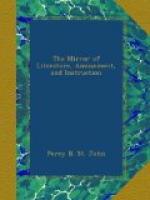In the next page we have the following character of an English artist of about the same period:—
“He was at once architect, sculptor, carpenter, goldsmith, armourer, jeweller, saddler, tailor, and painter. There is extant, in Dugdale, a curious example of the character of the times, and a scale by which we can measure the public admiration of art. It is a contract between the Earl of Warwick and John Rag, citizen and tailor, London, in which the latter undertakes to execute the emblazonry of the earl’s pageant in his situation of ambassador to France. In the tailor’s bill, gilded griffins mingle with Virgin Marys; painted streamers for battle or procession, with the twelve apostles; and ’one coat for his grace’s body, lute with fine gold,’ takes precedence of St. George and the Dragon.”
We wish some of the criticism in this chapter had been milder, and a few of the invectives not so highly charged; some of them even out-Herod the fury of an article on Painting, in a recent number of the Edinburgh Review. But we must pass on to pleasanter matters—as the following poetical paragraphs:—
“The art of tapestry as well as the art of illuminating books, aided in diffusing a love of painting over the island. It was carried to a high degree of excellence. The earliest account of its appearance in England is during the reign of Henry the Eighth, but there is no reason to doubt that it was well known and in general esteem much earlier. The traditional account, that we were instructed in it by the Saracens, has probably some foundation. The ladies encouraged this manufacture by working at it with their own hands; and the rich aided by purchasing it in vast quantities whenever regular practitioners appeared in the market. It found its way into church and palace—chamber and hall. It served at once to cover and adorn cold and comfortless walls. It added warmth, and, when snow was on the hill and ice in the stream, gave an air of social snugness which has deserted some of our modern mansions.
“At first the figures and groups, which rendered this manufacture popular, were copies of favourite paintings; but, as taste improved and skill increased, they showed more of originality in their conceptions, if not more of nature in their forms. They exhibited, in common with all other works of art, the mixed taste of the times—a grotesque union of classical and Hebrew history—of martial life and pastoral repose—of Greek gods and Romish saints. Absurd as such combinations certainly were, and destitute of those beauties of form and delicate gradations and harmony of colour which distinguish paintings worthily so called—still when the hall was lighted up, and living faces thronged the floor, the silent inhabitants of the walls would seem, in the eyes of our ancestors, something very splendid. As painting rose in fame, tapestry sunk in estimation. The introduction of a lighter and less massive mode of architecture abridged the space for its accommodation, and by degrees the stiff and fanciful creations of the loom vanished from our walls. The art is now neglected. I am sorry for this, because I cannot think meanly of an art which engaged the heads and hands of the ladies of England, and gave to the tapestried hall of elder days fame little inferior to what now waits on a gallery of paintings.”




